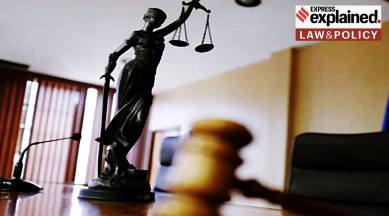Govt’s power to promulgate, repromulgate Ordinances — why and how
An Ordinance “shall have the same force and effect as an Act of Parliament”. But the government is required to bring an Ordinance before Parliament for ratification — and failure to do so will lead to its lapsing “at the expiration of six weeks from the reassembly of Parliament”.

On May 19, the central government promulgated an Ordinance that undid the unanimous verdict of a five-judge Constitution Bench of the Supreme Court, which on May 11 gave the Aam Aadmi Party (AAP) government of Delhi control over the transfer and posting of officials in the National Capital Territory (NCT), except with regard to public order, police, and land.
The Ordinance promulgated by President Droupadi Murmu gave the Lieutenant Governor of Delhi, who is appointed by the Centre, power over services, and established a “National Capital Civil Service Authority” comprising the Chief Minister and two senior IAS officials, which would decide matters “by majority of votes of the members present and voting” — essentially creating a situation in which the view of the elected CM could potentially be overruled.
Ordinance in Constitution
Under Article 123 of the Constitution (“Power of President to promulgate Ordinances during recess of Parliament”), “if at any time, except when both Houses of Parliament are in session, the President is satisfied that circumstances exist which render it necessary for him to take immediate action, he may promulgate such Ordinances as the circumstances appear to him to require.”
An Ordinance “shall have the same force and effect as an Act of Parliament”. But the government is required to bring an Ordinance before Parliament for ratification — and failure to do so will lead to its lapsing “at the expiration of six weeks from the reassembly of Parliament”.
The Ordinance may lapse earlier if the President withdraws it — or if both Houses pass resolutions disapproving it. (Rejection of an Ordinance would, however, imply the government has lost majority.)
Also, if an Ordinance makes a law that Parliament is not competent to enact under the Constitution, it shall be considered void.
Since the President acts on the advice of the Council of Ministers, it is in effect the government that decides to bring the Ordinance. The President may return the recommendation of the Cabinet once if she feels it warrants reconsideration; if it is sent back (with or without reconsideration), she has to promulgate it.
Article 213 deals with the broadly analogous powers of the Governor to promulgate/ withdraw an Ordinance when the state legislature is not in session.
An Ordinance is valid for six weeks, or 42 days, from the date on which the next session starts. If the two Houses start their sessions on different dates, the later date will be considered, say the explanations in Articles 123 and 213.
Repromulgation of Ordinance
If, for whatever reason, an Ordinance lapses, the only option for the government is to reissue or repromulgate it. In 2017, the Supreme Court examined a case where the state of Bihar re-promulgated an Ordinance several times without placing it before the legislature. (Krishna Kumar Singh and Another v. State of Bihar)
A seven-judge Bench of the court, which included now Chief Justice of India (CJI) D Y Chandrachud, reiterated that legislation should normally be done by the legislature, and the Governor’s power to issue an Ordinance is in the nature of an emergency power.
The court clarified that there might be circumstances permitting the re-promulgation of an Ordinance — however, it said, repeated re-promulgations without bringing the Ordinance to the legislature would usurp the legislature’s function, and will be unconstitutional.
The court declared the actions in that case to be “a fraud on constitutional power”, and said that the Ordinances were repromulgated in violation of the SC judgment in Dr D C Wadhwa and Ors v. State of Bihar and Ors (1986).
In D C Wadhwa, a challenge was mounted against the power of the Governor to repromulgate various Ordinances in Bihar, after 256 Ordinances were promulgated between 1967 and 1981, out of which 69 were repromulgated several times and kept alive with the permission of the President.
A Constitution Bench of the Supreme Court headed by then CJI P N Bhagwati held that “an Ordinance promulgated by the Governor to meet an emergent situation shall cease to be in operation at the expiration of six weeks from the reassembly of the Legislature.”
If the government wishes for the Ordinance to continue in force beyond the six-week period, it “has to go before the Legislature”, which is the constitutional authority entrusted with law-making functions.
The court also said that it would “most certainly be a colourable exercise of power for the Government to ignore the Legislature” and “repromulgate the Ordinance” while continuing to regulate the life and liberty of its citizens through Executive-made Ordinances.